Overview
- Brief Narrative
- Small set comprising a brass pen and pencil inside a case. The set is part of a collection illustrating the experiences of Moses Segen (b. 1914 in Radom, Poland) and Berta (nee Silberbusch, b. 1920 in Borczow, Poland) and their son Leon who was born in 1948 in Stuttgart, Germany. Family lived in Ludwigsburg resettlement camp near Stuttgart. Moses was interned in the Radom Ghetto from 1941 to 1943 at which time he fled. Berta, or Betka was interned in the Borczow Ghetto from 1941-1943 at which time she fled. They were both separately liberated in May 1945, moved to displaced persons camp, married and gave birth to Leon, then immigrated to the United States.
- Credit Line
- United States Holocaust Memorial Museum Collection, Gift of the Estate of Leon Segen
Physical Details
- Classification
-
Office Equipment and Supplies
- Category
-
Writing materials
- Object Type
-
Pens (lcsh)
- Physical Description
- Small set comprising a brass pen (a) and pencil (b) inside a case (c).
- Dimensions
- overall: Height: 3.500 inches (8.89 cm) | Width: 1.000 inches (2.54 cm)
- Materials
- overall : metal, thread
c : leather
Rights & Restrictions
- Conditions on Access
- No restrictions on access
- Conditions on Use
- No restrictions on use
Administrative Notes
- Legal Status
- Permanent Collection
- Provenance
- The pen and pencil set was donated to the United States Holocaust Memorial Museum in 2018 by the Estate of Leon Segen.
- Record last modified:
- 2022-07-28 20:13:54
- This page:
- https://collections.ushmm.org/search/catalog/irn611733
Download & Licensing
In-Person Research
- By Appointment
- Request 21 Days in Advance of Visit
- Plan a Research Visit
- Request to See This Object
Contact Us
Also in Segen family collection
The Segen family collection consist of biographical materials, resettlement and immigration papers, restitution papers, correspondence, photographs, childrens clothing and artifacts documenting the experiences of Berta and Moses Segen in the Borszczów and Radom, Poland ghettos; their time in resettlement camps in Germany; and their immigration to the United States in 1949.
Date: 1911-2003
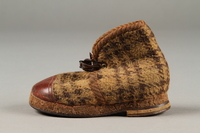
Pair of children's boots
Object
Pair of children's ankle boots. Fabric upper with brown and tan checkered pattern. Metal fastener holds each shoe onto foot. Leather trim on toe. The boots are part of a collection illustrating the experiences of Moses Segen (b. 1914 in Radom, Poland) and Berta (nee Silberbusch, b. 1920 in Borczow, Poland) and their son Leon who was born in 1948 in Stuttgart, Germany. Family lived in Ludwigsburg resettlement camp near Stuttgart. Moses was interned in the Radom Ghetto from 1941 to 1943 at which time he fled. Berta, or Betka was interned in the Borczow Ghetto from 1941-1943 at which time she fled. They were both separately liberated in May 1945, moved to displaced persons camp, married and gave birth to Leon, then immigrated to the United States.
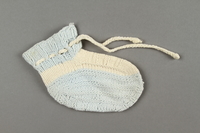
Pair of baby booties
Object
Pair of blue and white knit baby booties.The booties are part of a collection illustrating the experiences of Moses Segen (b. 1914 in Radom, Poland) and Berta (nee Silberbusch, b. 1920 in Borczow, Poland) and their son Leon who was born in 1948 in Stuttgart, Germany. Family lived in Ludwigsburg resettlement camp near Stuttgart. Moses was interned in the Radom Ghetto from 1941 to 1943 at which time he fled. Berta, or Betka was interned in the Borczow Ghetto from 1941-1943 at which time she fled. They were both separately liberated in May 1945, moved to displaced persons camp, married and gave birth to Leon, then immigrated to the United States.
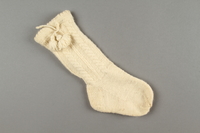
Pair of children's socks
Object
Pair of cream colored knit wool socks with tassels. The socks are part of a collection illustrating the experiences of Moses Segen (b. 1914 in Radom, Poland) and Berta (nee Silberbusch, b. 1920 in Borczow, Poland) and their son Leon who was born in 1948 in Stuttgart, Germany. Family lived in Ludwigsburg resettlement camp near Stuttgart. Moses was interned in the Radom Ghetto from 1941 to 1943 at which time he fled. Berta, or Betka was interned in the Borczow Ghetto from 1941-1943 at which time she fled. They were both separately liberated in May 1945, moved to displaced persons camp, married and gave birth to Leon, then immigrated to the United States.
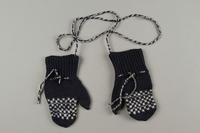
Pair of children's mittens
Object
Pair of navy and white knit wool mittens with string keeping the mittens together. The mittens are part of a collection illustrating the experiences of Moses Segen (b. 1914 in Radom, Poland) and Berta (nee Silberbusch, b. 1920 in Borczow, Poland) and their son Leon who was born in 1948 in Stuttgart, Germany. Family lived in Ludwigsburg resettlement camp near Stuttgart. Moses was interned in the Radom Ghetto from 1941 to 1943 at which time he fled. Berta, or Betka was interned in the Borczow Ghetto from 1941-1943 at which time she fled. They were both separately liberated in May 1945, moved to displaced persons camp, married and gave birth to Leon, then immigrated to the United States.
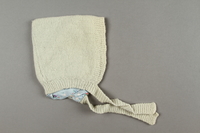
Baby bonnet
Object
Light green wool baby bonnet with blue floral patterned lining. The bonnet is part of a collection illustrating the experiences of Moses Segen (b. 1914 in Radom, Poland) and Berta (nee Silberbusch, b. 1920 in Borczow, Poland) and their son Leon who was born in 1948 in Stuttgart, Germany. Family lived in Ludwigsburg resettlement camp near Stuttgart. Moses was interned in the Radom Ghetto from 1941 to 1943 at which time he fled. Berta, or Betka was interned in the Borczow Ghetto from 1941-1943 at which time she fled. They were both separately liberated in May 1945, moved to displaced persons camp, married and gave birth to Leon, then immigrated to the United States.
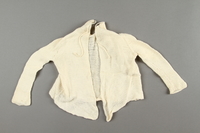
Baby sweater
Object
Cream colored knit baby sweater.The sweater is part of a collection illustrating the experiences of Moses Segen (b. 1914 in Radom, Poland) and Berta (nee Silberbusch, b. 1920 in Borczow, Poland) and their son Leon who was born in 1948 in Stuttgart, Germany. Family lived in Ludwigsburg resettlement camp near Stuttgart. Moses was interned in the Radom Ghetto from 1941 to 1943 at which time he fled. Berta, or Betka was interned in the Borczow Ghetto from 1941-1943 at which time she fled. They were both separately liberated in May 1945, moved to displaced persons camp, married and gave birth to Leon, then immigrated to the United States.
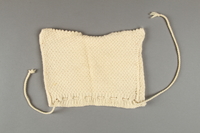
Child's wool hat
Object
Cream colored wool hat. The hat is part of a collection illustrating the experiences of Moses Segen (b. 1914 in Radom, Poland) and Berta (nee Silberbusch, b. 1920 in Borczow, Poland) and their son Leon who was born in 1948 in Stuttgart, Germany. Family lived in Ludwigsburg resettlement camp near Stuttgart. Moses was interned in the Radom Ghetto from 1941 to 1943 at which time he fled. Berta, or Betka was interned in the Borczow Ghetto from 1941-1943 at which time she fled. They were both separately liberated in May 1945, moved to displaced persons camp, married and gave birth to Leon, then immigrated to the United States.
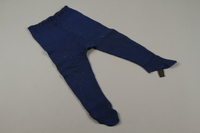
Child's wool pants
Object
Navy knit wool pants orl tights with elastic around waist and elastic stirrups. The pants are part of a collection illustrating the experiences of Moses Segen (b. 1914 in Radom, Poland) and Berta (nee Silberbusch, b. 1920 in Borczow, Poland) and their son Leon who was born in 1948 in Stuttgart, Germany. Family lived in Ludwigsburg resettlement camp near Stuttgart. Moses was interned in the Radom Ghetto from 1941 to 1943 at which time he fled. Berta, or Betka was interned in the Borczow Ghetto from 1941-1943 at which time she fled. They were both separately liberated in May 1945, moved to displaced persons camp, married and gave birth to Leon, then immigrated to the United States.
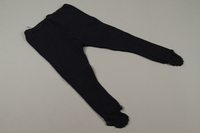
Child's wool pants
Object
Navy knit wool pants orl tights with elastic around waist and elastic stirrups. The pants are part of a collection illustrating the experiences of Moses Segen (b. 1914 in Radom, Poland) and Berta (nee Silberbusch, b. 1920 in Borczow, Poland) and their son Leon who was born in 1948 in Stuttgart, Germany. Family lived in Ludwigsburg resettlement camp near Stuttgart. Moses was interned in the Radom Ghetto from 1941 to 1943 at which time he fled. Berta, or Betka was interned in the Borczow Ghetto from 1941-1943 at which time she fled. They were both separately liberated in May 1945, moved to displaced persons camp, married and gave birth to Leon, then immigrated to the United States.
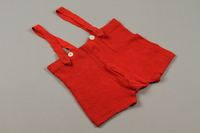
Child's short pants with suspenders
Object
Red knit shorts with suspenders. The pants are part of a collection illustrating the experiences of Moses Segen (b. 1914 in Radom, Poland) and Berta (nee Silberbusch, b. 1920 in Borczow, Poland) and their son Leon who was born in 1948 in Stuttgart, Germany. Family lived in Ludwigsburg resettlement camp near Stuttgart. Moses was interned in the Radom Ghetto from 1941 to 1943 at which time he fled. Berta, or Betka was interned in the Borczow Ghetto from 1941-1943 at which time she fled. They were both separately liberated in May 1945, moved to displaced persons camp, married and gave birth to Leon, then immigrated to the United States.
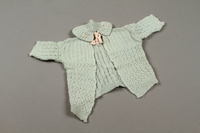
Baby sweater
Object
Blue wool knit sweater with pink tie at the neck and flower detail on the collar. The sweater is part of a collection illustrating the experiences of Moses Segen (b. 1914 in Radom, Poland) and Berta (nee Silberbusch, b. 1920 in Borczow, Poland) and their son Leon who was born in 1948 in Stuttgart, Germany. Family lived in Ludwigsburg resettlement camp near Stuttgart. Moses was interned in the Radom Ghetto from 1941 to 1943 at which time he fled. Berta, or Betka was interned in the Borczow Ghetto from 1941-1943 at which time she fled. They were both separately liberated in May 1945, moved to displaced persons camp, married and gave birth to Leon, then immigrated to the United States.
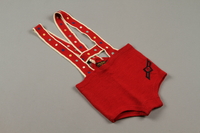
Knit baby shorts with suspenders
Object
Red knit shorts with suspenders. A label reading "Benger-Ribana" is sewn onto the back of the shorts, and there is a patch with the letter "R" sewn onto the front of the shorts. The built-in suspenders are decorated with multicolored embroidered polka dots. The shorts are part of a collection illustrating the experiences of Moses Segen (b. 1914 in Radom, Poland) and Berta (nee Silberbusch, b. 1920 in Borczow, Poland) and their son Leon who was born in 1948 in Stuttgart, Germany. Family lived in Ludwigsburg resettlement camp near Stuttgart. Moses was interned in the Radom Ghetto from 1941 to 1943 at which time he fled. Berta, or Betka was interned in the Borczow Ghetto from 1941-1943 at which time she fled. They were both separately liberated in May 1945, moved to displaced persons camp, married and gave birth to Leon, then immigrated to the United States.
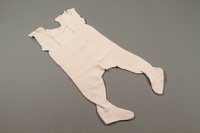
Knit romper
Object
Light pink knit footed romper. Sleeveless, with embroidery and white plastic buttons.The romper is part of a collection illustrating the experiences of Moses Segen (b. 1914 in Radom, Poland) and Berta (nee Silberbusch, b. 1920 in Borczow, Poland) and their son Leon who was born in 1948 in Stuttgart, Germany. Family lived in Ludwigsburg resettlement camp near Stuttgart. Moses was interned in the Radom Ghetto from 1941 to 1943 at which time he fled. Berta, or Betka was interned in the Borczow Ghetto from 1941-1943 at which time she fled. They were both separately liberated in May 1945, moved to displaced persons camp, married and gave birth to Leon, then immigrated to the United States.
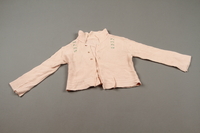
Child's sweater
Object
Light pink knit cardigan sweater with floral embroidery.The sweater is part of a collection illustrating the experiences of Moses Segen (b. 1914 in Radom, Poland) and Berta (nee Silberbusch, b. 1920 in Borczow, Poland) and their son Leon who was born in 1948 in Stuttgart, Germany. Family lived in Ludwigsburg resettlement camp near Stuttgart. Moses was interned in the Radom Ghetto from 1941 to 1943 at which time he fled. Berta, or Betka was interned in the Borczow Ghetto from 1941-1943 at which time she fled. They were both separately liberated in May 1945, moved to displaced persons camp, married and gave birth to Leon, then immigrated to the United States.
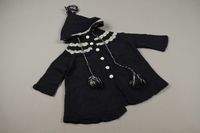
Child's hooded sweater coat
Object
Child's navy knit hooded sweater or coat. Buttoned with tassles. Light gray knit details on the tassles and along neckline and hood. The sweater is part of a collection illustrating the experiences of Moses Segen (b. 1914 in Radom, Poland) and Berta (nee Silberbusch, b. 1920 in Borczow, Poland) and their son Leon who was born in 1948 in Stuttgart, Germany. Family lived in Ludwigsburg resettlement camp near Stuttgart. Moses was interned in the Radom Ghetto from 1941 to 1943 at which time he fled. Berta, or Betka was interned in the Borczow Ghetto from 1941-1943 at which time she fled. They were both separately liberated in May 1945, moved to displaced persons camp, married and gave birth to Leon, then immigrated to the United States.
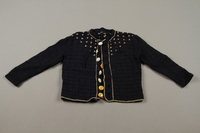
Child's sweater
Object
Child's navy knit cardigan sweater with light gray trim and polka dots along the neckline. The sweater has a mixture of yellow and white buttons. The sweater is part of a collection illustrating the experiences of Moses Segen (b. 1914 in Radom, Poland) and Berta (nee Silberbusch, b. 1920 in Borczow, Poland) and their son Leon who was born in 1948 in Stuttgart, Germany. Family lived in Ludwigsburg resettlement camp near Stuttgart. Moses was interned in the Radom Ghetto from 1941 to 1943 at which time he fled. Berta, or Betka was interned in the Borczow Ghetto from 1941-1943 at which time she fled. They were both separately liberated in May 1945, moved to displaced persons camp, married and gave birth to Leon, then immigrated to the United States.
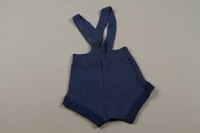
Child's knit shortalls
Object
Navy knit shortalls. The clothing is part of a collection illustrating the experiences of Moses Segen (b. 1914 in Radom, Poland) and Berta (nee Silberbusch, b. 1920 in Borczow, Poland) and their son Leon who was born in 1948 in Stuttgart, Germany. Family lived in Ludwigsburg resettlement camp near Stuttgart. Moses was interned in the Radom Ghetto from 1941 to 1943 at which time he fled. Berta, or Betka was interned in the Borczow Ghetto from 1941-1943 at which time she fled. They were both separately liberated in May 1945, moved to displaced persons camp, married and gave birth to Leon, then immigrated to the United States.
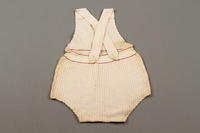
Child's romper
Object
Light pink knit romper with suspenders.The clothing is part of a collection illustrating the experiences of Moses Segen (b. 1914 in Radom, Poland) and Berta (nee Silberbusch, b. 1920 in Borczow, Poland) and their son Leon who was born in 1948 in Stuttgart, Germany. Family lived in Ludwigsburg resettlement camp near Stuttgart. Moses was interned in the Radom Ghetto from 1941 to 1943 at which time he fled. Berta, or Betka was interned in the Borczow Ghetto from 1941-1943 at which time she fled. They were both separately liberated in May 1945, moved to displaced persons camp, married and gave birth to Leon, then immigrated to the United States.
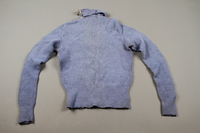
Blue turtleneck sweater
Object
Blue turtleneck sweater with zipper in back. Large child's size or small adult size.The clothing is part of a collection illustrating the experiences of Moses Segen (b. 1914 in Radom, Poland) and Berta (nee Silberbusch, b. 1920 in Borczow, Poland) and their son Leon who was born in 1948 in Stuttgart, Germany. Family lived in Ludwigsburg resettlement camp near Stuttgart. Moses was interned in the Radom Ghetto from 1941 to 1943 at which time he fled. Berta, or Betka was interned in the Borczow Ghetto from 1941-1943 at which time she fled. They were both separately liberated in May 1945, moved to displaced persons camp, married and gave birth to Leon, then immigrated to the United States.
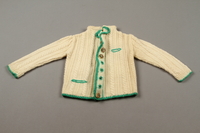
Child's lederhosen and cardigan sweater set
Object
Cream colored knit cardigan sweater (a) and lederhosen (b) set with green yarn trim and plastic buttons. The clothing is part of a collection illustrating the experiences of Moses Segen (b. 1914 in Radom, Poland) and Berta (nee Silberbusch, b. 1920 in Borczow, Poland) and their son Leon who was born in 1948 in Stuttgart, Germany. Family lived in Ludwigsburg resettlement camp near Stuttgart. Moses was interned in the Radom Ghetto from 1941 to 1943 at which time he fled. Berta, or Betka was interned in the Borczow Ghetto from 1941-1943 at which time she fled. They were both separately liberated in May 1945, moved to displaced persons camp, married and gave birth to Leon, then immigrated to the United States.
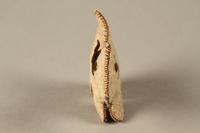
Toy dog made of wool
Object
Toy scottie dog made of wool with a felt scarf. The toy is part of a collection illustrating the experiences of Moses Segen (b. 1914 in Radom, Poland) and Berta (nee Silberbusch, b. 1920 in Borczow, Poland) and their son Leon who was born in 1948 in Stuttgart, Germany. Family lived in Ludwigsburg resettlement camp near Stuttgart. Moses was interned in the Radom Ghetto from 1941 to 1943 at which time he fled. Berta, or Betka was interned in the Borczow Ghetto from 1941-1943 at which time she fled. They were both separately liberated in May 1945, moved to displaced persons camp, married and gave birth to Leon, then immigrated to the United States.
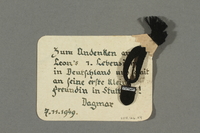
Handcrafted card with souvenir pendant attached
Object
Handcrafted card with color drawing of a bee on a flower. The verso is inscribed with a handwritten note in German from "Dagmar" and is dated 7.11.1949. The verso has a slot to which is attached a shield-shaped souvenir pendant or charm from Stuttgart hanging from a loop of black thread. The card with souvenir pendant is part of a collection illustrating the experiences of Moses Segen (b. 1914 in Radom, Poland) and Berta (nee Silberbusch, b. 1920 in Borczow, Poland) and their son Leon who was born in 1948 in Stuttgart, Germany. Family lived in Ludwigsburg resettlement camp near Stuttgart. Moses was interned in the Radom Ghetto from 1941 to 1943 at which time he fled. Berta, or Betka was interned in the Borczow Ghetto from 1941-1943 at which time she fled. They were both separately liberated in May 1945, moved to displaced persons camp, married and gave birth to Leon, then immigrated to the United States.
Segen family papers
Document
The Segen family papers consist of biographical materials, resettlement and immigration papers, restitution papers, correspondence, and photographs documenting the experiences of Berta and Moses Segen in the Borszczów and Radom, Poland ghettos; their time in resettlement camps in Germany; and their immigration to the United States in 1949. The papers include birth certificates, immigration applications, restitution testimonies, correspondence, and family photographs. The biographical material includes birth certificates, an extensive Silberbusch family tree in Hebrew, and business papers related to the dissolution of a business Moses co-owned. The resettlement and immigration papers include travel arrangements from the displaced person camp in Stuttgart to the United States, immigration applications, and naturalization certificates. The restitution papers include testimonies from Berta and Moses and bank statements. The correspondence includes letters to Berta from her sister Hela in Israel, a letter from Moses requesting a visitor’s visa for Hela to visit the United States from Israel to be present for Leon’s Bar Mitzvah, and copies of two emails exchanged between Leon and Hela’s son Moshe about their parents’ respective decisions to emigrate to the United States and Israel. The photographs primarily consist of baby and childhood photographs of Leon as well as photographs of Berta and Moses while in Stuttgart and their passport pictures. Also included are three photographs of Moses’s family. One picture is likely of soldiers in uniform from circa 1916, and the two others are of his family in Radom, Poland, 1933. The printed material includes a German photograph book and Hebrew/English calendar and reference book.



